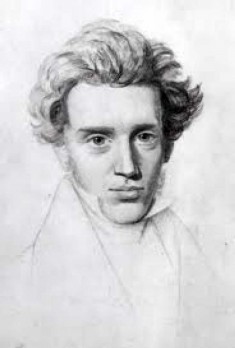| Soren Kierkegaard | |
|---|---|
 |
|
| Philosopher | |
| Specialty | Existentialism |
| Born | May 5, 1813 Copenhagen, Denmark |
| Died | Nov. 11, 1855 (at age 42) Copenhagen, Denmark |
| Nationality | Danish |
Soren Kierkegaard was a Danish philosopher. He is generally regarded as the first of the existentialists. Kierkegaard wrote widely on subjects, ranging from morality to psychology, using a style which emphasized ironic metaphors. A large proportion of his output underlines the importance he placed on individualism and reality. Kierkegaard was unimpressed by the idealism shown by a number of his contemporaries, especially Goethe and Hegel.
Early Life and Education
Kierkegaard was born in Copenhagen on May 5, 1813, to two parents who were both well into middle age. His father was deeply religious, and the young boy was taught in a way which frequently emphasized the suffering of Jesus Christ. This may have influenced his decision to study theology. In his late teens, he enrolled at the University of Copenhagen to study this as well as literature and philosophy.
When his mother died in 1834, Kierkegaard began to keep a journal, which he continued to do for the rest of his life. His motivation for this was that he felt he needed to understand his own nature better in order to realize how he should spend his adult life.
Career Highlights
Soren left home for good in 1837, and became a Latin teacher in Borgerdydskolen. The following year, after the death of his father, Kierkegaard produced a critique of a novel by Hans Christian Andersen, whose idealism already irritated him. His personal life impinged on his work in 1840, when he was briefly engaged to a woman he had been friendly with since the start of his independent life.
The relationship broke up rather quickly, due in part to Kierkegaard’s belief that he would be unable to continue his philosophical study if he were distracted by the responsibilities of a domestic life. For a decade, he became something of a recluse, devoting himself to writing.
Kierkegaard’s Mature Work
 Kierkegaard’s doctoral dissertation, On the Concept of Irony with Continual Reference to Socrates, was published in 1841 and was his first significant book on philosophy. This brought him into conflict with the then-dominant view promoted by Hegel that life could be understood in a purely rational manner. Kierkegaard felt, rather, that the person was immortal and that whether to believe in God was not a problem with a theoretical answer but instead an act of freely-chosen faith.
Kierkegaard’s doctoral dissertation, On the Concept of Irony with Continual Reference to Socrates, was published in 1841 and was his first significant book on philosophy. This brought him into conflict with the then-dominant view promoted by Hegel that life could be understood in a purely rational manner. Kierkegaard felt, rather, that the person was immortal and that whether to believe in God was not a problem with a theoretical answer but instead an act of freely-chosen faith.
He went on to expand on his religious ideas in several of his other books, in particular The Concept of Dread in 1844. At this stage in his career, he published under a range of pseudonyms, allowing him to experiment with mutually conflicting statements.
The year 1843 also saw Kierkegaard produce the important text – Either/Or. This work demonstrates his philosophies regarding what he called the ethical and aesthetic lives. The ethical life is founded on the eternal and infinite, as well as on a variety of moral codes. Contrastingly, the aesthetic life rests upon physical and intellectual pleasures relating to the senses in the concrete universe around us.
Kierkegaard suggested that remaining devoted to a purely aesthetic way of life was a sure way to fall victim to angst, and as a result to fall into eventual despair. Only once this fact was understood could a person truly begin an ethical existence.
Later Works of Kierkegaard
In 1846, Kierkegaard produced his Concluding Unscientific Postscript, which rested on the idea that subjectivity was in fact truth. He again rejected the Hegelian notion of the human spirit being subject to objective scientific understanding, stating in forthright terms that objectivity is not capable of explaining human existence.
Kierkegaard used the term “impassioned interest” to explain the condition of faith, emphasizing that this could not be achieved simply through scholarship. He wrote that the highest truth anyone could reach was the way in which he or she related to the implicit uncertainty of Christian faith itself, a theme he continued in his next book, Works of Love, in 1847.
Kierkegaard’s own spirituality underwent a severe crisis in 1848, and he began to make sharp attacks on what he saw as the complacent nature of the Church. This deliberate provocation was undertaken with the aim of rousing Christians to anger and thereby to a closer, stronger relationship with Christianity itself. In 1850, Practice in Christianity was published.
Kierkegaard saw this as his major work as it attacked what he felt was the Danish Church’s lack of seriousness. Later in the decade, he wrote several articles under his own name in which he complained about the Church’s policy that all Danes were automatically Christian by birth. These were collected into a book, Attack Upon Christendom, but while compiling it, Kierkegaard fell ill with a spinal condition. A few weeks later, on November 11, 1855, he died.